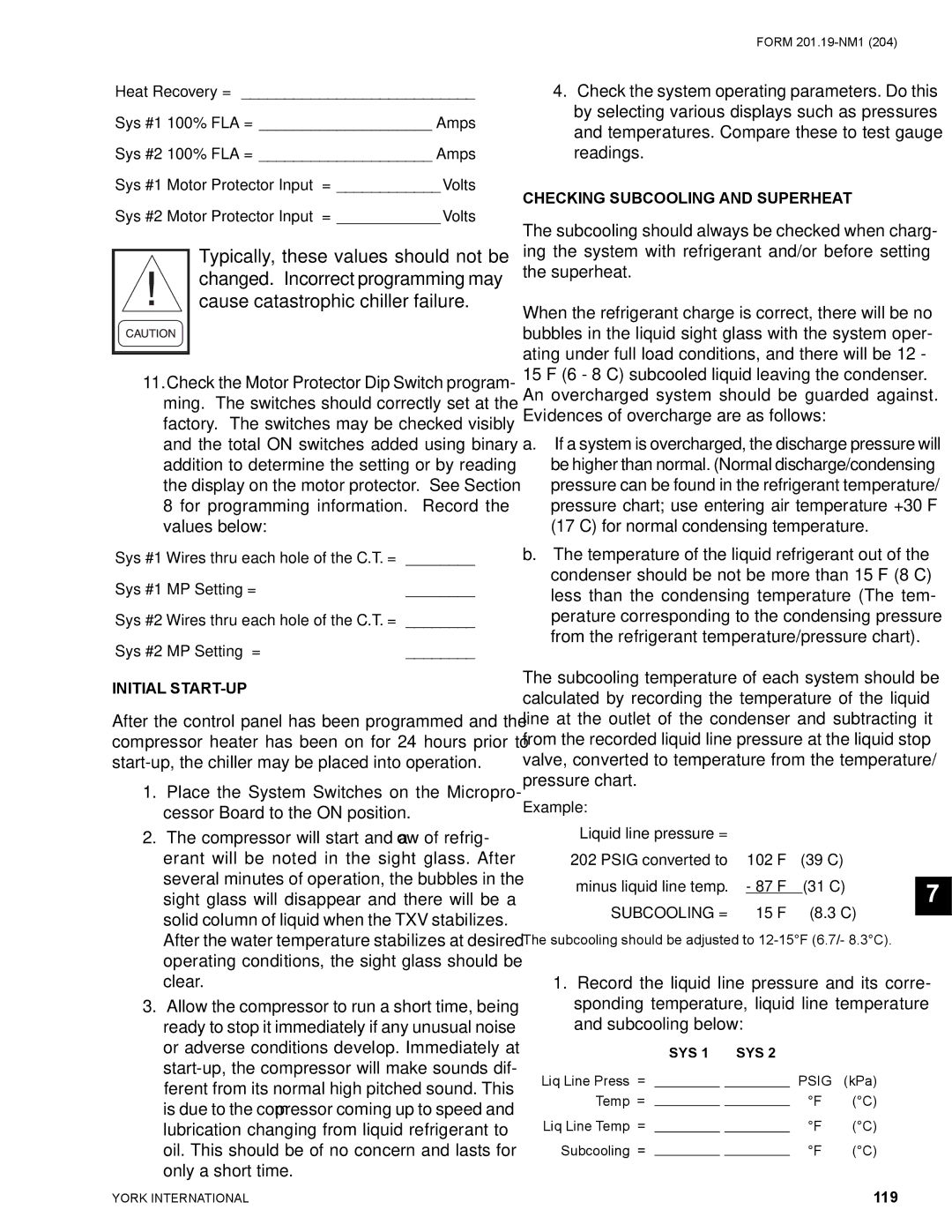
Heat Recovery = ___________________________
Sys #1 100% FLA = ____________________ Amps
Sys #2 100% FLA = ____________________ Amps
Sys #1 Motor Protector Input = ____________ Volts
Sys #2 Motor Protector Input = ____________ Volts
Typically, these values should not be changed. Incorrect programming may cause catastrophic chiller failure.
11.Check the Motor Protector Dip Switch program- ming. The switches should correctly set at the factory. The switches may be checked visibly and the total ON switches added using binary addition to determine the setting or by reading the display on the motor protector. See Section 8 for programming information. Record the values below:
Sys #1 Wires thru each hole of the C.T. = | ________ |
Sys #1 MP Setting = | ________ |
Sys #2 Wires thru each hole of the C.T. = | ________ |
Sys #2 MP Setting = | ________ |
INITIAL
After the control panel has been programmed and the compressor heater has been on for 24 hours prior to
1.Place the System Switches on the Micropro- cessor Board to the ON position.
2.The compressor will start and a flow of refrig- erant will be noted in the sight glass. After several minutes of operation, the bubbles in the sight glass will disappear and there will be a solid column of liquid when the TXV stabilizes. After the water temperature stabilizes at desired operating conditions, the sight glass should be clear.
3.Allow the compressor to run a short time, being ready to stop it immediately if any unusual noise or adverse conditions develop. Immediately at
FORM
4.Check the system operating parameters. Do this by selecting various displays such as pressures and temperatures. Compare these to test gauge readings.
CHECKING SUBCOOLING AND SUPERHEAT
The subcooling should always be checked when charg- ing the system with refrigerant and/or before setting the superheat.
When the refrigerant charge is correct, there will be no bubbles in the liquid sight glass with the system oper- ating under full load conditions, and there will be 12 - 15°F (6 - 8°C) subcooled liquid leaving the condenser. An overcharged system should be guarded against. Evidences of overcharge are as follows:
a.If a system is overcharged, the discharge pressure will be higher than normal. (Normal discharge/condensing pressure can be found in the refrigerant temperature/ pressure chart; use entering air temperature +30°F (17°C) for normal condensing temperature.
b.The temperature of the liquid refrigerant out of the condenser should be not be more than 15°F (8°C) less than the condensing temperature (The tem- perature corresponding to the condensing pressure from the refrigerant temperature/pressure chart).
The subcooling temperature of each system should be calculated by recording the temperature of the liquid line at the outlet of the condenser and subtracting it from the recorded liquid line pressure at the liquid stop valve, converted to temperature from the temperature/ pressure chart.
Example: |
|
|
Liquid line pressure = |
|
|
202 PSIG converted to | 102°F | (39°C) |
minus liquid line temp. | - 87°F | (31°C) |
SUBCOOLING = | 15°F | (8.3°C) |
The subcooling should be adjusted to
1.Record the liquid line pressure and its corre- sponding temperature, liquid line temperature and subcooling below:
|
| SYS 1 |
| SYS 2 |
| |
Liq Line Press = |
|
| PSIG | (kPa) | ||
Temp = |
|
|
| °F | (°C) | |
Liq Line Temp | = |
|
|
| °F | (°C) |
Subcooling | = |
|
|
| °F | (°C) |
7
YORK INTERNATIONAL | 119 |
